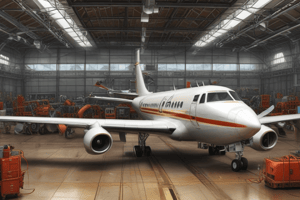Podcast
Questions and Answers
What is the primary concern when weighing an aircraft?
What is the primary concern when weighing an aircraft?
- Using mechanical scales that depend on the ATR version
- Avoiding weight measurement of a wet or iced aircraft (correct)
- Ensuring the hydraulic system is topped up
- Removing all trace of grease, dirt, or water from the aircraft
What is the minimum number of clinometers required for measuring aircraft pitch attitude?
What is the minimum number of clinometers required for measuring aircraft pitch attitude?
- Three
- Four
- One (correct)
- Two
What is the purpose of replenishing the potable water system?
What is the purpose of replenishing the potable water system?
- To top off the hydraulic system
- To support the weighing process
- To provide water for the toilets (correct)
- To clean the aircraft exterior
Where are the load cell points located during weighing on jacks?
Where are the load cell points located during weighing on jacks?
What is the primary purpose of defueling the tanks prior to weighing?
What is the primary purpose of defueling the tanks prior to weighing?
How many mechanical scales are required for weighing on wheels?
How many mechanical scales are required for weighing on wheels?
What is the recommended location for the clinometer in the aircraft?
What is the recommended location for the clinometer in the aircraft?
What is the correct location for jacking points during weighing on jacks and wheels?
What is the correct location for jacking points during weighing on jacks and wheels?
What is the purpose of checking the remaining fuel quantity in the weight and balance manual?
What is the purpose of checking the remaining fuel quantity in the weight and balance manual?
What is the purpose of noting tire characteristics?
What is the purpose of noting tire characteristics?
What is the configuration of the aircraft's control surfaces during weighing and levelling?
What is the configuration of the aircraft's control surfaces during weighing and levelling?
What document provides information on the maximum permissible load on each weighing point?
What document provides information on the maximum permissible load on each weighing point?
Why is it essential to clean the aircraft before weighing?
Why is it essential to clean the aircraft before weighing?
Why is it essential to remove blanking plates, protection, and covers during aircraft preparation?
Why is it essential to remove blanking plates, protection, and covers during aircraft preparation?
What is the primary purpose of weighing the aircraft on jack and wheels?
What is the primary purpose of weighing the aircraft on jack and wheels?
In which location should the aircraft be placed during weighing and levelling?
In which location should the aircraft be placed during weighing and levelling?
Flashcards are hidden until you start studying
Study Notes
Weighing and Levelling
- Three weighing techniques can be used: weighing on jack, weighing on wheels, and weighing on jack and wheels.
Pre-Weighing Preparation
- Defuel tanks by suction and drain to remove remaining fuel.
- Ensure pitch and roll attitude are at 0° during defueling.
- Check remaining fuel quantity in weight and balance manual (one table per aircraft version).
Aircraft Preparation
- Place aircraft in a closed hangar.
- Equip with one clinometer at cargo compartment door between frame 14 and frame 17 to measure aircraft pitch attitude = 0.
- Ensure aircraft configuration meets the following conditions: • Flaps retracted. • Control surfaces and trim in neutral position. • Spoilers retracted. • All doors and exits closed. • Blanking plates, protection, and covers removed. • No object or workstand in contact with aircraft.
- Make a list of missing equipment and ensure: • Hydraulic system is topped up. • Engine oil replenished. • Toilets replenished with water and applicable materials. • Potable water system topped up. • Tire characteristics noted.
- Clean aircraft to remove grease, dirt, or water.
- CAUTION: Do not weigh wet or iced aircraft.
Weighing Methods
Weighing on Jack
- Jacking and load cell point location: • 1 or 2 points on the nose. • 1 point for each wing. • 1 safety stay on tail cone.
- Note: Load cell depends on ATR version.
- Maximum permissible load on each point is given in Job Instruction Card (reference n° 08-12-00).
Weighing on Wheels
- Mechanical scales location: • 1 on the nose. • 2 for the main gears.
- Note: Mechanical scales depend on ATR version.
- Three scales must have pans large enough to contain the landing gear tires.
Weighing on Jack and Wheels
- Mechanical scales and jacking point location: • 1 scale and 1 jack for the nose.
Studying That Suits You
Use AI to generate personalized quizzes and flashcards to suit your learning preferences.




